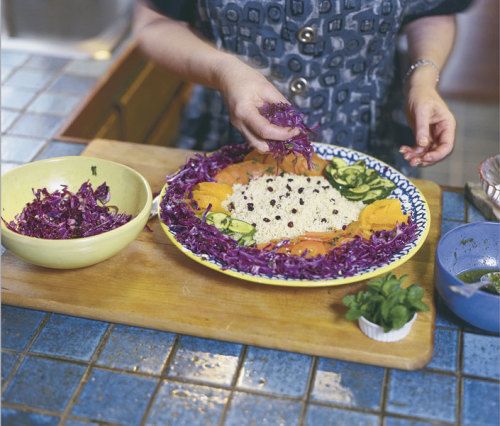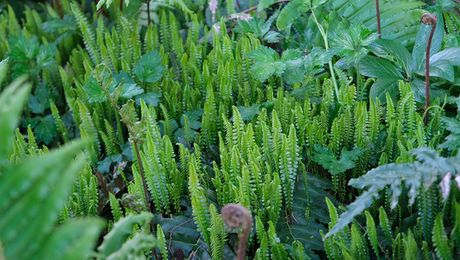
by Michele Anna Jordan
August 1996
from issue #4
Imagine a platter of sliced cherry tomatoes nestling against succulent wedges of grilled eggplant and crisp lemon cucumbers. Nearby, tender leeks and new potatoes surround a fillet of grilled tuna sitting atop a nest of arugula. A mustardy dressing is drizzled over all. This is a composed salad—a medley of raw and cooked ingredients placed together to create striking contrasts.
I love composed salads, perhaps a lingering bias from my childhood when, a fussy eater, I didn’t like foods touching each other, let alone mixed together. I liked distinct flavors and textures even then, and I still do, though I no longer avoid the edges where one ingredient mingles with another. A composed
salad is the ideal way to savor each ingredient individually, but at the same time enjoy how the flavors mix together and play off each other.
The composed salad at its finest offers a beautiful opportunity to show off produce harvested at its peak. The possibilities are virtually limitless because the ingredients can be changed to take advantage of the season and what’s on hand. And in addition to the delicious taste of the salad, you’re treated to an arresting visual presentation. Contrasting colors and textures, for instance crisp purple cabbage sitting beside juicy orange slices, catch your eye with their mouthwatering appearance.
But perhaps most appealing of all is the simplicity of a composed salad. Most of the ingredients can and should be peeled, chopped, or cooked in advance. The final assembly of the salad is easy, as long as you have all of the ingredients prepared and at hand. Composed salads are ideal when you’re entertaining, since most of the work is done ahead of time. These salads serve as one-dish meals—a simple appetizer and a light dessert are the only accompaniments you’ll need—making them an easy choice for entertaining.
Vegetables are the stars. You want to show off your vegetables, so how they’re prepared is important to both the taste and appearance of a composed salad. Some of the vegetables—tomatoes, avocado, radishes, cucumbers, fennel, and greens—keep their color and texture best raw. Others—potatoes, green beans, beets, eggplant, asparagus, and corn—obviously must be cooked. Certain vegetables that are frequently eaten raw—carrots, zucchini, broccoli, and mushrooms among them—are better cooked. Their flavors are coaxed out and they combine better with other ingredients when their raw crunch, so appealing for a quick nibble, is tamed by appropriate cooking.
Fruit adds a sweet taste. Composed salads can go beyond just savory ingredients, so don’t overlook the possibilities presented by seasonal fruits. One of my most successful salads combines strawberries with thinly sliced fennel and grilled prawns. I also use sliced lemons that I preserve in a mixture of salt, sugar, and lemon juice. They add tang to the salad, and make a beautiful garnish. Other fruits—pears, peaches, apricots, plums, raspberries, melons of all types—also contribute a bright color and a sweet taste to composed salads.
Dressing holds it all together. Nearly as important as the primary ingredients in a composed salad is the dressing, which is the common thread that ties the various ingredients together. I avoid dressings that will dominate or eclipse the character of the ingredients themselves; a composed salad is not a chef’s salad drenched with ranch dressing. Instead, the dressing should be subtle and somewhat delicate, such as a lemon dressing (see the recipe on the facing page). Sometimes all that is needed is flavorful extra-virgin olive oil.
The right dressing can also add an ethnic dimension to a composed salad. For an Asian touch, try a simple vinaigrette of rice vinegar and toasted sesame oil over prawns, broccoli, mushrooms, young mustard greens, and Chinese noodles. For a Thai flair, use a simple mixture of fish sauce, lime juice, garlic, hot peppers, and cilantro. This dressing is ideal for salads that feature beef, pork, or chicken.
Arrange the salad to create contrasts. There are no set rules on how to arrange a composed salad, so don’t worry. It’s most important to consider the qualities—texture, color, and taste—of each ingredient. The best-looking and best-tasting salads use contrast to highlight these qualities. So place a cooked vegetable next to a raw one; an orange one next to a dark green one; a rich, creamy ingredient next to a crisp, bright one. Keep experimenting until you find what you like best.
A composed salad also offers the opportunity for fanciful garnishes and whimsical touches. A scattering of rose petals, perhaps, or a few sprigs of tiny currant tomatoes will add a delightful touch, as will flowering herbs or tiny stars cut from lemon and orange peels.
The following recipes demonstrate two simple ways to arrange a composed salad, each of which can be served as a main dish. The Fragrant Orange Salad with Cilantro and Mint best shows its vibrant colors arranged on a platter, while the Lemony Grilled Tuna and Arugula Salad is served on individual plates.
Preparation of the ingredients can be time consuming, but most of the work can be done ahead of time. And don’t feel intimidated by the long list of ingredients. The large variety of fresh vegetables provides the contrast in colors, flavors, and textures you’re looking for.
Fine Gardening Recommended Products

A.M. Leonard Deluxe Soil Knife & Leather Sheath Combo
Fine Gardening receives a commission for items purchased through links on this site, including Amazon Associates and other affiliate advertising programs.

Razor-Back Potato/Refuse Hook
Fine Gardening receives a commission for items purchased through links on this site, including Amazon Associates and other affiliate advertising programs.

Gardener's Log Book from NYBG
Fine Gardening receives a commission for items purchased through links on this site, including Amazon Associates and other affiliate advertising programs.



















Comments
I really happy to visit here your article and must say it is the mots wonderfull information about the garden so getting the remember passwords in microsoft edge in computer here batter way for the save all data to access the windows setting of password so thanks a lot for the update of security forever.
Log in or create an account to post a comment.
Sign up Log in